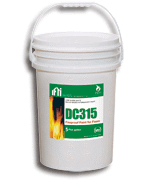
DC 315 Thermal Barrier
Dc 315 is an interior ignition or thermal barrier coating for spray polyurethane foam insulation. Depending on your particular application, an ignition or a thermal barrier are required by building code. DC 315 is water based latex system that dries quickly and reaches maximum properties in less than 14 days.
DC 315 over polyurethane foam to prevent surface ignition due to a flame source. This product will inhibit or prevent the start and spread of flame encountered on the surface and is designed to be a long term protective barrier.
Product Use
- DC 315 is a coating specifically formulated for application over spray foam insulation. DC 315 will inhibit or prevent the start and spread of flame, The coating can be used as an ignition barrier or thermal barrier depending on the thickness installed over the foam. The manufactures of spray foam products, have performed extensive testing using DC 315 over open and closed cell foams to determine the appropriate thickness of DC 315 needed to meet building Code.
- DC 315 is water based paint that is typically applied with a paint sprayer, brush or roller
Code
- DC 315 complies with ICC-ES AC 377 Appendix X (Modified NFPA 286) concerning fire protection and spray foam insulation. As of Jan 1, 2011 ALL brands of spray foam must meet the criteria of Appendix X to meet building code.
- The 2009 IBC and IRC (and earlier editions) require that unless otherwise allowed, “foam plastic shall be separated from the interior of a building by an approved thermal barrier of minimum ½ inch (12.7 mm) gypsum wallboard or an approved finish material equivalent to a thermal barrier that will limit the average temperature rise of the unexposed surface to no more than 250EF (139EC) after 25 minutes of fire exposure complying with the ASTM E 119 or UL 263 standard time temperature curve. The thermal barrier shall be installed in such a manner that it will remain in place for 15 minutes based on NFPA 286 with the acceptance criteria of Section R302.9.4, FM 4880, UL 1040 or UL 1715.” [Quoted here from 2009 IRC, Section R316.4.]
- The building codes permit alternative assemblies to the above quoted thermal barrier requirements under 2009 IBC Section 2603.9 Special Approval and 2009 IRC Section R316.6 Specific Approval. In essence, these sections permit approval based on the NFPA 286 test (and others) related to actual end-use configurations. Since NFPA 286 does not provide a pass/fail acceptance criteria, the code specifically provides that the test must pass in accordance with the acceptance criteria in 2009 IBC Section 803.1.2.1 or 2009 IRC Section R302.9.4. (Note: 2009 IBC actually references the NFPA 286 acceptance criteria in Section 803.2, but this is a typographical error due to section renumbering of the 2006 IBC; 803.1.2.1 is the intended section.)
2009 IBC 803.1.2.1 reads as follows:
803.1.2.1 Acceptance criteria for NFPA 286. During the 40 kW exposure, the interior finish shall comply with Item 1. During the 160 kW exposure, the interior finish shall comply with Item 2. During the entire test, the interior finish shall comply with Items 3 and 4.
During the 40 kW exposure, flames shall not spread to the ceiling.
- During the 160 kW exposure, the interior finish shall comply with the following:
- Flame shall not spread to the outer extremity of the sample on any wall or ceiling.
- Flashover, as defined in NFPA 286, shall not occur.
- The peak rate of heat release throughout the NFPA 286 test shall not exceed 800 kW.
- The total smoke released throughout the NFPA 286 test shall not exceed 1,000 m2.
- 2009 International Building Code: Sections 803.1.2.1; 2603.4; 2603.9.
- 2009 International Residential Code: Sections R302.9.4; R316.4; R316.6.
- 2006 International Building Code: Sections 803.2.1; 2603.4; 2603.9.
- 2006 International Residential Code: Sections R315.4; R314.4; R314.6.
- Intertek Test Report No. 100220209SAT-002B, November 22, 2010.
- NPFA 286 Standard Methods of Fire Tests for Evaluating Contribution of Wall and Ceiling Interior Finish to Room Fire Growth

DC315 Certified Warnock Hersey (WH) Approved Thermal - Ignition Barrier
|
Properties |
Value |
|
Finish |
Flat |
|
Color: |
Off-White |
|
V.O.C. |
47 g/L |
|
Solids By Volume |
67% |
|
Type of Cure |
Coalescence |
|
Drying Time |
@77°F & 50% R.H. – To touch 1 – 2 hours, to recoat if required 2 to 4 hours |
|
Reducing or Cleaning |
Water |
|
Shelf Life |
2 years from date of manufacture in unopened |
|
5 Gallon Pails Weight |
58 lbs. |
|
55 Gallon Drum Weight |
640 lbs |